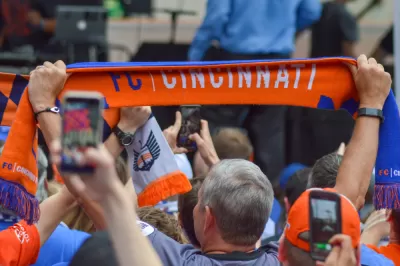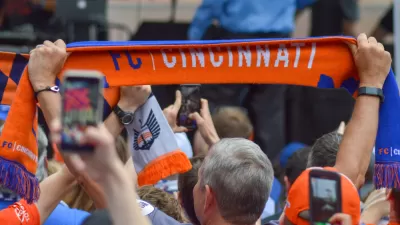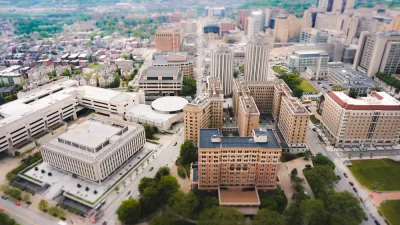The Major League Soccer Team FC Cincinnati is planning on building a stadium, along with attached mixed-use development, in the West End neighborhood of its hometown.

"FC Cincinnati filed more detailed preliminary plans for its $200 million soccer stadium in the West End with the Cincinnati Planning Commission this week," reports Nick Swartsell.
The plan is much more than just a stadium and a parking lot, according to Swartsell. The team is also considering retail, residential and office developments around the stadium on Central Parkway and Wade Streets.
Swartsell also shares details on the team's plan to address two of the biggest concerns when it comes to new stadiums, parking and uses. On that latter issue, the team plans 25 games during its first year of operation in 2021, with three of four additional concerts or events throughout the year.
As for parking:
FCC would construct about 500 of the required 5,300 parking spaces onsite in the form of underground garages and surface lots, while Hamilton County will build a parking garage just outside the stadium off of Central Parkway with another 500-1,000 spaces. The team says the rest of the parking will come from various sites within about two-thirds of a mile of the facility.
The article includes a link to the zoning change request that contains the plans, and a lot of additional detail about the plan.
FULL STORY: Everything We Know about FC Cincinnati's West End Stadium Plans

Study: Maui’s Plan to Convert Vacation Rentals to Long-Term Housing Could Cause Nearly $1 Billion Economic Loss
The plan would reduce visitor accommodation by 25,% resulting in 1,900 jobs lost.

North Texas Transit Leaders Tout Benefits of TOD for Growing Region
At a summit focused on transit-oriented development, policymakers discussed how North Texas’ expanded light rail system can serve as a tool for economic growth.

Why Should We Subsidize Public Transportation?
Many public transit agencies face financial stress due to rising costs, declining fare revenue, and declining subsidies. Transit advocates must provide a strong business case for increasing public transit funding.

How to Make US Trains Faster
Changes to boarding platforms and a switch to electric trains could improve U.S. passenger rail service without the added cost of high-speed rail.

Columbia’s Revitalized ‘Loop’ Is a Hub for Local Entrepreneurs
A focus on small businesses is helping a commercial corridor in Columbia, Missouri thrive.

Invasive Insect Threatens Minnesota’s Ash Forests
The Emerald Ash Borer is a rapidly spreading invasive pest threatening Minnesota’s ash trees, and homeowners are encouraged to plant diverse replacement species, avoid moving ash firewood, and monitor for signs of infestation.
Urban Design for Planners 1: Software Tools
This six-course series explores essential urban design concepts using open source software and equips planners with the tools they need to participate fully in the urban design process.
Planning for Universal Design
Learn the tools for implementing Universal Design in planning regulations.
Ascent Environmental
Borough of Carlisle
Institute for Housing and Urban Development Studies (IHS)
City of Grandview
Harvard GSD Executive Education
Toledo-Lucas County Plan Commissions
Salt Lake City
NYU Wagner Graduate School of Public Service




























